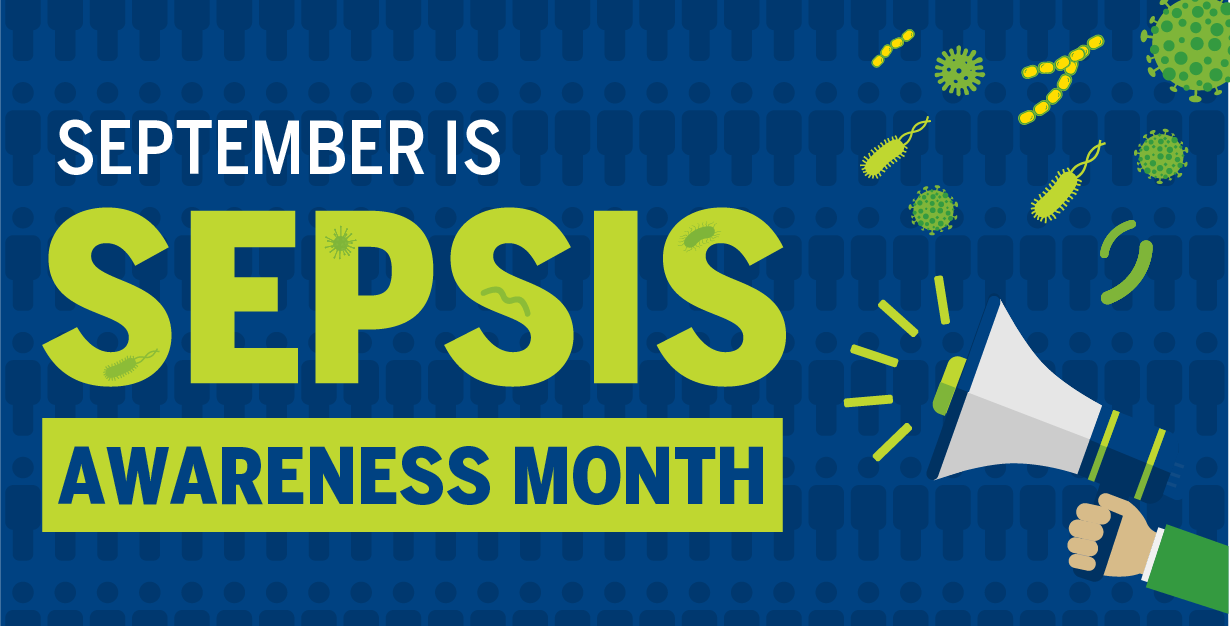By the bioMérieux Connection Editors
Since 2011, September has been designated as Sepsis Awareness Month by the Sepsis Alliance. The month is dedicated to raising awareness of sepsis—the leading cause of death in U.S. hospitals.
Understanding what sepsis is, its causes, and treatment is always important, particularly as the COVID-19 pandemic continues to shape conversations about infectious disease. COVID-19, along with all other infections, can lead to sepsis. The most common cause of sepsis is pneumonia, which is a frequent complication of severe COVID-19 infections. The intersection of COVID-19 and sepsis infection is important to understand as the pandemic continues to evolve, impacting healthcare systems and patients.
Understanding sepsis and its causes can aid in rapid diagnosis and effective treatment, saving lives. Whether or not you are a healthcare professional, you have the chance to make a life-saving impact by helping to raise awareness during Sepsis Awareness Month.
What is Sepsis?
Sepsis is the body’s extreme life-threatening response to a severe infection. Due to its potential severity, sepsis requires prompt diagnosis and treatment. It is a medical emergency that can ultimately lead to organ failure, tissue damage, or even death.
The human body typically can fight off germs to stop or prevent infection, sometimes with the additional aid of medication. However, sepsis occurs when the body’s immune system stops fighting the germs of an infection and turns on itself. Sepsis can quickly progress to septic shock, a life-threatening condition resulting from a swift drop in blood pressure to a dangerously low level.
Sepsis is quite prevalent—each year in the United States, over 1.7 million adults will develop sepsis, which means that a sepsis diagnosis occurs every 20 seconds. Over 270,000 individuals in the U.S. die from sepsis each year. Children are also at risk for sepsis, with approximately 6,800 dying from sepsis each year—more than from pediatric cancers.
Sepsis Causes and Symptoms
Anyone, regardless of age or health, can get an infection, and nearly all infections have the potential to lead to sepsis. Sepsis can be bacterial, viral, or fungal. Bacterial infections cause the majority of sepsis cases, and infections that lead to sepsis most often start in the lungs, urinary tract, skin, or gastrointestinal tract.
Some groups are at higher risk for sepsis, including those who:
- Are over 65 years of age
- Are under the age of 1
- Were recently hospitalized
- Have chronic medical conditions (such as diabetes or cancer)
- Have a weakened immune system
- Have previously survived sepsis
Sepsis is often diagnosed based on a set of signs and symptoms, including results from certain types of lab tests. To easily explain sepsis symptoms that lead to diagnosis, Sepsis Alliance created the “T.I.M.E.” acronym:
- T – Temperature: Abnormal temperature, higher or lower than usual
- I – Infection: Signs or symptoms of an infection
- M – Mental Decline: Signs of being confused or sleepy
- E – Extremely Ill: Pain, discomfort, shortness of breath
What We Know about Sepsis and COVID-19
The relationship between COVID-19 and sepsis has been monitored since the beginning of the pandemic. Research indicates parallels between severe COVID-19 infections and the onset of viral sepsis.
Pneumonia, a common complication of severe COVID-19 infection and a leading cause of sepsis, is an infection of the lungs that causes an inflammation of air sacs that ranges in severity and can cause breathing difficulties. A pneumonia infection caused by COVID-19 may lead to the onset of sepsis, which can leave lasting damage to the lungs.
The American Medical Association added the following about the relationship of COVID-19 and sepsis to its website in late 2020: “Surviving severe COVID-19 means surviving viral sepsis. And while there is little published data on long-term outcomes of severe COVID-19, what is known is that recovering from sepsis caused by other pathogens is a long and difficult process that includes, among other things, increased odds of cognitive impairment and functional limitations—even down to inability to bathe, toilet or dress independently.”
Although extensive research is still being conducted to better understand the link between COVID-19, sepsis, and its lasting effects, the relationship between the two is significant and continues to impact sepsis patients worldwide.
Sepsis Treatment and Prevention
Rapid diagnosis and treatment of sepsis are key to saving patients’ lives. Preventing sepsis is not always possible, but the risk can be greatly lowered with certain prevention measures and swift, effective treatment for underlying infections.
Sepsis prevention includes staying up to date with vaccinations, proper hygiene habits, and proactively seeking medical treatment when infection is suspected. Awareness ties directly into prevention.
Once someone has been diagnosed with sepsis, treatment often includes the administration of antimicrobial medicines, which are determined by the cause of the infection and other clinical information. Bacterial infections are treated with antibiotics, fungal infections with antifungals, and viral infections with antivirals. In addition to antimicrobial therapy, a patient diagnosed with sepsis will also require a hospital stay, close monitoring, and supportive care.
Effective and prompt antimicrobial therapy is essential to sepsis treatment and survival, bringing conversations about antimicrobial resistance (AMR) and stewardship (AMS) to the forefront. Rapid, precise infection diagnosis can help limit the administration of inappropriate antibiotics and preserve the efficacy of these life-saving drugs.
Importance of Sepsis Awareness Month
Sepsis can affect anyone, and as the threat of COVID-19 continues to impact millions of patients worldwide, increasing awareness of sepsis is more important than ever. Everyone can help save lives by raising awareness of sepsis.
Follow bioMérieux to learn more about sepsis during the month of September and visit https://www.sepsis.org/get-involved/ways-to-give/ to learn how you can give, advocate, or engage with Sepsis Alliance throughout the month. Share resources on your social media accounts, and be sure to use the hashtag, #SAM2021 to contribute to the conversation!
Opinions expressed in this article are not necessarily those of bioMérieux, Inc.



